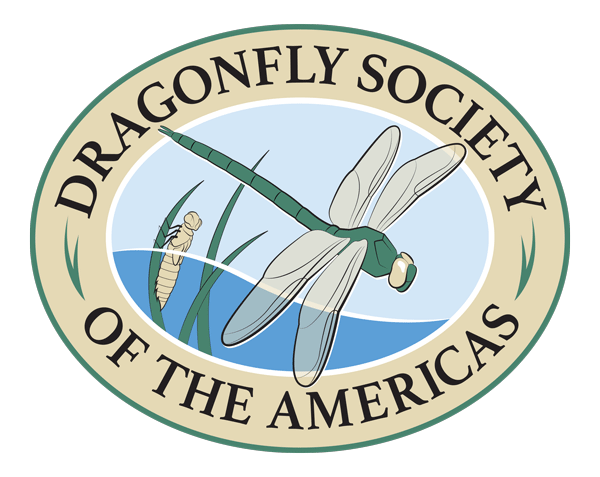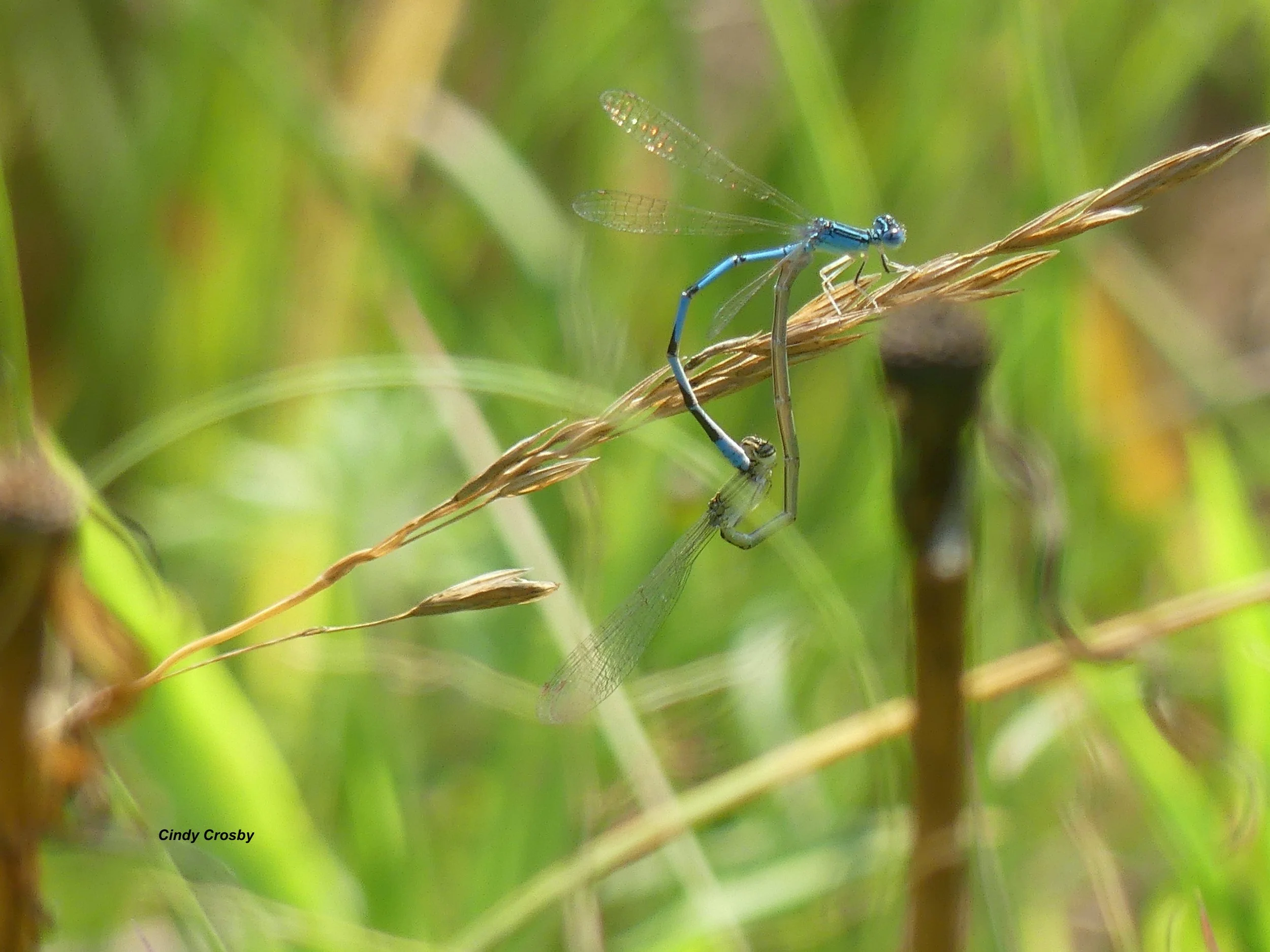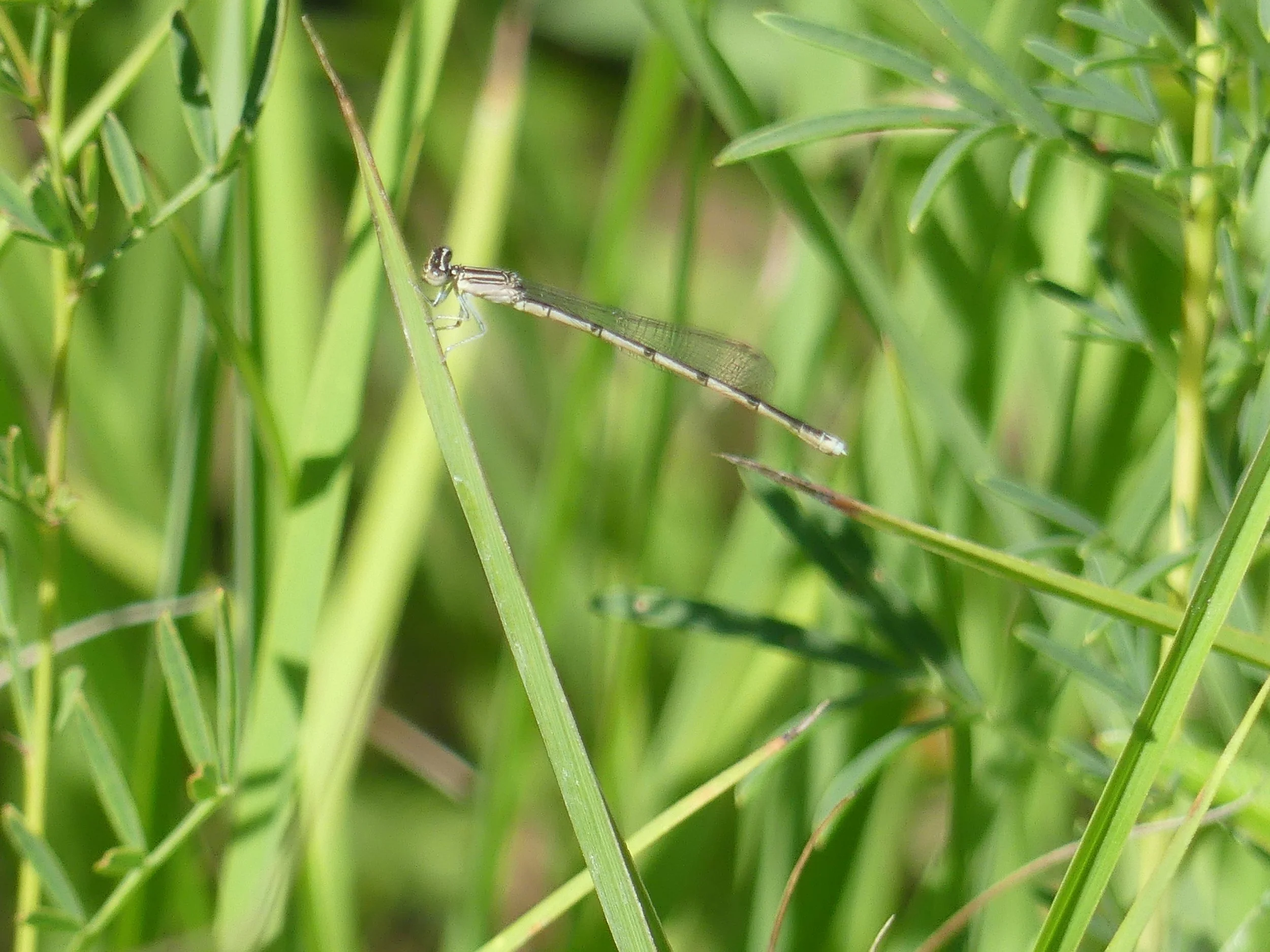Double-striped Bluet (Enallagma basidens) male, Short Pioneer Cemetery Prairie Nature Preserve, Coal City, Illinois (7-5-25). Photo Cindy Crosby.
November 2025 Species of the Month
Double-striped Bluet Damselfly (Enallagma basidens)
The November “Species of the Month” is the Double-striped Bluet (Enallagma basidens) damselfly, in the family Coenagrionidae, the Pond Damsels. These tiny bluets (about an inch long/2.54 centimeters) are unmistakable for their double thoracic stripes. Dennis Paulson tells us in his guide, Dragonflies and Damselflies of the East, that Double-striped Bluets are likely to be found in slow-moving streams with abundant emergent vegetation, around lakes, and in ponds. It’s a wide-ranging North American species (into Ontario, Canada) and also occurs in northern Mexico. It is expanding its range into the east and north portions of the United States, Paulson notes. Join DSA blog editor Cindy Crosby as she encounters this lovely diminutive species at an unlikely place.
A Very Prairie Cemetery Encounter
You never know where you’ll see a damselfly.
In 2025, my husband Jeff and I set out to do a “25 hikes in 2025”—exploring 25 different natural areas new to us in 25 Illinois counties over the year. Illinois, our home state for 27 years, was once covered by 22 million acres of tallgrass prairie. A lack of fire, which was needed to keep out trees and brush, paired with rapid development and the 1800’s invention of the John Deere plow decimated the prairie, and in one generation, almost all of it disappeared. Today, the Illinois Natural History Survey has found only about 2,300 acres of original prairie left in the state. Most of this is along old railroad rights-of-way, in corners of old farms, and on rocky hilltops, which were too difficult to cultivate. Some of the highest quality prairie remnants are in old pioneer cemeteries which were not cared for, mowed, or sprayed with herbicide and still have the original tallgrass vegetation.
Short Pioneer Cemetery Prairie Nature Preserve, Coal City, Illinois (7-5-25). Photo Cindy Crosby.
As a former prairie steward, I love to wander old tallgrass prairie remnants, relics of another time and place. It’s to one of these old cemeteries, Short Pioneer Cemetery Prairie Nature Preserve, that we are headed today. In Coal City (Grundy County), just southwest of Chicago, this one-acre-plus resting place for some of Illinois’s first non-indigenous settlers was established in the mid-1800s.
It’s not easy to find. Google sends us to a farmhouse—not unusual for these old prairie remnant directions—which have also sent us to cornfields and gravel roads over the course of the past year. This is our 15th county in our 2025 hiking attempt, and we’ve been at it long enough not to get discouraged. We know to keep driving and looking.
Aha! A signpost beckons off a nearby road. We park and walk down a gravel road toward a gated cemetery. There, amid the broken headstones and sunken monuments, are the remnants of what once was our state’s “landscape of home.” Leadplant. Clustered poppy mallow. Wild bergamot. All the signs of a remnant tallgrass prairie.
Short Pioneer Cemetery Prairie Nature Preserve, Coal City, Illinois (7-5-25). Photo Cindy Crosby.
Plenty of poison ivy, too. We step carefully as we explore. The July heat is oppressive, but the beauty of the native prairie wildflowers keeps us “oohing” and “ahhing.” Among the headstones is an unexpected surprise: the cemetery is alive with dragonflies and damselflies.
Eastern Pondhawk (Erythemis simplicicollis) female, on clustered poppy mallow, Short Pioneer Cemetery Prairie, Coal City, Illinois. (7-5-25) Photo Cindy Crosby.
Eastern Amberwings are having one of their best seasons in recent memory, and they have turned out in force today.
Eastern Amberwing (Perithemis tenera) male, Short Pioneer Cemetery Prairie Nature Preserve, Coal City, Illinois (7-5-25). Photo Cindy Crosby.
There are many other odonate species, including the usual Midwestern ones such as the Widow Skimmers (Libellula luctuosa). But the most abundant species are the Double-striped Bluet damselflies. Everywhere.
Double-striped Bluet (Enallagma basidens) male, Short Pioneer Cemetery Prairie Nature Preserve, Coal City, Illinois (7-5-25). Photo Cindy Crosby.
Tiny bluets are in motion around our feet, low in the grasses. Many are in the wheel position.
Double-striped Bluets (Enallagma basidens) male and female in the wheel, Short Pioneer Cemetery Prairie Nature Preserve, Coal City, Illinois (7-5-25). Photo Cindy Crosby.
In my more than two decades of collecting data on dragonflies and damselflies as a citizen scientist for a number of organizations, I could count the number of Double-striped Bluets I’ve seen on one hand. Why are there so many here? It’s overwhelming.
Double-striped Bluet (Enallagma basidens) male, Short Pioneer Cemetery Prairie Nature Preserve, Coal City, Illinois (7-5-25). Photo Cindy Crosby.
Perhaps unusual among the bluets is that the Double-striped Bluet is fairly simple to identify. I have terrible eyesight, so my close-focus binoculars and camera’s zoom lens help me zero in on the damselflies. Once in focus, I can tell the females and males both have the double thoracic stripe. I know from my field guides that they are one of the “blue-type bluets,” predominantly blue with black markings. Is there anything as tiny and blue as a male Double-striped Bluet? Their diminutive size seems to emphasize their color. Little azure sparks in motion. The females I see in the Midwest are lovely, with their tan coloration tending toward light blue.
Double-striped Bluet (Enallagma basidens) female, Short Pioneer Cemetery Prairie Nature Preserve, Coal City, Illinois (7-5-25). Photo Cindy Crosby.
I know from my guide Dragonflies and Damselflies of the East that these bluets are usually found around slow streams, lake edges, and ponds. No water is in evidence here, but I imagine there is a pond or stream just out of sight. Speaking of water…a drink sounds good right now. Hot, sweaty, and yes—beaten by the oppressive heat—we finally leave the old cemetery. Like all of our hikes this year, this one has been full of wonderful surprises. Jeff and I thought we knew what we were going to see, and indeed, we did see remnant prairie wildflowers and grasses and plenty of Illinois’ history.
But the real delight of this preserve was its diversity of damselflies and dragonflies. I’ll always remember these Double-striped Bluets, magical among the gravestones and monuments. An ancient species, in one of Illinois’s older cemeteries. I like to think the pioneers buried here would be happy to know their resting place is now an honored, protected place of such color, motion, and joy.
Cindy Crosby has been editor of Dragonfly Society of the America’s “Species of the Month” blog since its inception in 2021. Her most recent book is “Chasing Dragonflies: A Natural, Cultural, and Personal History” (Northwestern University Press). She leads a team that collects data at Nachusa Grasslands, a 4,000-acre Nature Conservancy site in Franklin Grove, Illinois, and another team that does the same at 2,318-acre The Morton Arboretum in Lisle, Illinois. She and her husband, Jeff, begin their hikes from their home just west of Chicago, where they enjoy the dragonflies that come to their small suburban yard and tiny pond. Contact Cindy at phrelanzer@gmail.com. She’s always looking for blog contributors.










